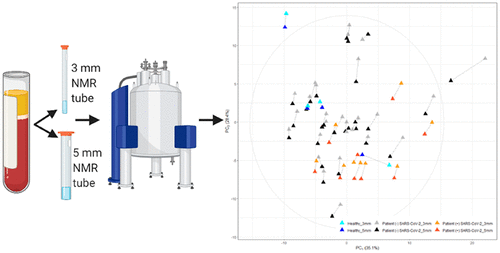当前位置:
X-MOL 学术
›
J. Proteome Res.
›
论文详情
Our official English website, www.x-mol.net, welcomes your
feedback! (Note: you will need to create a separate account there.)
Low Volume in Vitro Diagnostic Proton NMR Spectroscopy of Human Blood Plasma for Lipoprotein and Metabolite Analysis: Application to SARS-CoV-2 Biomarkers
Journal of Proteome Research ( IF 3.8 ) Pub Date : 2021-01-23 , DOI: 10.1021/acs.jproteome.0c00815 Samantha Lodge 1 , Philipp Nitschke 1 , Ruey Leng Loo 1, 2 , Torben Kimhofer 1, 2 , Sze-How Bong 1 , Toby Richards 3 , Sofina Begum 1, 4 , Manfred Spraul 5 , Hartmut Schaefer 5 , John C Lindon 4 , Elaine Holmes 1, 2, 4 , Jeremy K Nicholson 1, 2, 6
Journal of Proteome Research ( IF 3.8 ) Pub Date : 2021-01-23 , DOI: 10.1021/acs.jproteome.0c00815 Samantha Lodge 1 , Philipp Nitschke 1 , Ruey Leng Loo 1, 2 , Torben Kimhofer 1, 2 , Sze-How Bong 1 , Toby Richards 3 , Sofina Begum 1, 4 , Manfred Spraul 5 , Hartmut Schaefer 5 , John C Lindon 4 , Elaine Holmes 1, 2, 4 , Jeremy K Nicholson 1, 2, 6
Affiliation

|
The utility of low sample volume in vitro diagnostic (IVDr) proton nuclear magnetic resonance (1H NMR) spectroscopic experiments on blood plasma for information recovery from limited availability or high value samples was exemplified using plasma from patients with SARS-CoV-2 infection and normal controls. 1H NMR spectra were obtained using solvent-suppressed 1D, spin–echo (CPMG), and 2-dimensional J-resolved (JRES) spectroscopy using both 3 mm outer diameter SampleJet NMR tubes (100 μL plasma) and 5 mm SampleJet NMR tubes (300 μL plasma) under in vitro diagnostic conditions. We noted near identical diagnostic models in both standard and low volume IVDr lipoprotein analysis (measuring 112 lipoprotein parameters) with a comparison of the two tubes yielding R2 values ranging between 0.82 and 0.99 for the 40 paired lipoprotein parameters samples. Lipoprotein measurements for the 3 mm tubes were achieved without time penalty over the 5 mm tubes as defined by biomarker recovery for SARS-CoV-2. Overall, biomarker pattern recovery for the lipoproteins was extremely similar, but there were some small positive offsets in the linear equations for several variables due to small shimming artifacts, but there was minimal degradation of the biological information. For the standard untargeted 1D, CPMG, and JRES NMR experiments on the same samples, the reduced signal-to-noise was more constraining and required greater scanning times to achieve similar differential diagnostic performance (15 min per sample per experiment for 3 mm 1D and CPMG, compared to 4 min for the 5 mm tubes). We conclude that the 3 mm IVDr method is fit-for-purpose for quantitative lipoprotein measurements, allowing the preparation of smaller volumes for high value or limited volume samples that is common in clinical studies. If there are no analytical time constraints, the lower volume experiments are equally informative for untargeted profiling.
中文翻译:

用于脂蛋白和代谢物分析的人血浆低容量体外诊断质子核磁共振波谱:在 SARS-CoV-2 生物标志物中的应用
通过使用来自 SARS-CoV-2 感染患者的血浆和正常控制。使用 3 mm 外径 SampleJet NMR 管(100 µL 等离子体)和 5 mm SampleJet NMR 管,通过溶剂抑制的 1D、自旋回波 (CPMG) 和 2 维 J 分辨 (JRES) 光谱获得 1 H NMR谱(300 μL 血浆)在体外诊断条件下。我们注意到标准和低容量 IVDr 脂蛋白分析(测量 112 个脂蛋白参数)中的诊断模型几乎相同,通过比较两个管,得出40 个配对脂蛋白参数样品的R 2值范围在 0.82 和 0.99 之间。与 5 毫米管相比,3 毫米管的脂蛋白测量没有时间损失(根据 SARS-CoV-2 生物标志物回收率的定义)。总体而言,脂蛋白的生物标志物模式恢复非常相似,但由于小的匀场伪影,几个变量的线性方程中存在一些小的正偏移,但生物信息的退化最小。对于相同样品的标准非靶向 1D、CPMG 和 JRES NMR 实验,降低的信噪比更具限制性,并且需要更长的扫描时间才能实现类似的差异诊断性能(对于 3 mm 1D 和实验,每个样品每次实验 15 分钟) CPMG,相比之下,5 毫米管需要 4 分钟)。我们得出的结论是,3 mm IVDr 方法适合定量脂蛋白测量,可以为临床研究中常见的高价值或有限体积样品制备较小体积的样品。如果没有分析时间限制,则较低体积的实验对于非目标分析同样能提供丰富的信息。
更新日期:2021-02-05
中文翻译:

用于脂蛋白和代谢物分析的人血浆低容量体外诊断质子核磁共振波谱:在 SARS-CoV-2 生物标志物中的应用
通过使用来自 SARS-CoV-2 感染患者的血浆和正常控制。使用 3 mm 外径 SampleJet NMR 管(100 µL 等离子体)和 5 mm SampleJet NMR 管,通过溶剂抑制的 1D、自旋回波 (CPMG) 和 2 维 J 分辨 (JRES) 光谱获得 1 H NMR谱(300 μL 血浆)在体外诊断条件下。我们注意到标准和低容量 IVDr 脂蛋白分析(测量 112 个脂蛋白参数)中的诊断模型几乎相同,通过比较两个管,得出40 个配对脂蛋白参数样品的R 2值范围在 0.82 和 0.99 之间。与 5 毫米管相比,3 毫米管的脂蛋白测量没有时间损失(根据 SARS-CoV-2 生物标志物回收率的定义)。总体而言,脂蛋白的生物标志物模式恢复非常相似,但由于小的匀场伪影,几个变量的线性方程中存在一些小的正偏移,但生物信息的退化最小。对于相同样品的标准非靶向 1D、CPMG 和 JRES NMR 实验,降低的信噪比更具限制性,并且需要更长的扫描时间才能实现类似的差异诊断性能(对于 3 mm 1D 和实验,每个样品每次实验 15 分钟) CPMG,相比之下,5 毫米管需要 4 分钟)。我们得出的结论是,3 mm IVDr 方法适合定量脂蛋白测量,可以为临床研究中常见的高价值或有限体积样品制备较小体积的样品。如果没有分析时间限制,则较低体积的实验对于非目标分析同样能提供丰富的信息。











































 京公网安备 11010802027423号
京公网安备 11010802027423号